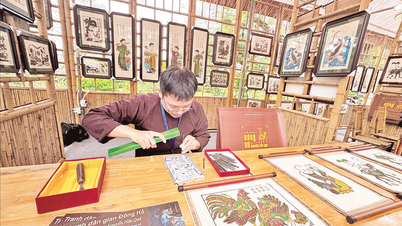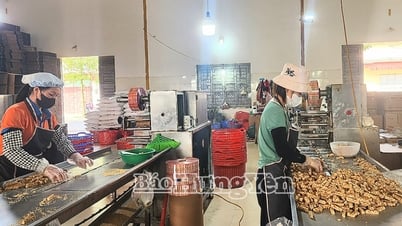The answer given by the program is "Looking up at the bamboo rafters of the roof/ The more bamboo rafters there are, the more I miss my grandparents."
In the commentary section, the program's advisor - Doctor DH commented: "We must admit that this part is a bit difficult. For example, the part that used the folk song "Looking up at the bamboo rafters of the roof/ The more bamboo rafters, the more we miss our ancestors... This is using the principle of the South. Therefore, the word "nuoc lat" is also called "nuoc lat". Because in the past, we often roofed our houses with thatch and coconut leaves, so we had to tie them with bamboo rafters, and tie a lot of those bamboo rafters, which means that the merit of our ancestors and grandparents is limitless".
The above lecture of Dr. DH has two basic mistakes.
1. "Nuoc" does not mean "button"
What is a “button”?
“Knot” is the place where the two ends of the rope are tied together, or the point where the rope is tightened. With soft ropes, the knot is created by threading the two ends of the rope across each other and tying them (usually a double knot is needed - tying twice to be secure). With elastic ropes, the knot is created by twisting the joint of the two ends of the rope. If twisted many times, it creates a spiral, which is commonly called “twisted dove shit” (it looks like dove shit, they eat seeds so the shit is dry and twisted).
So what is a “nuoc”? A “nuoc” is a loop of rope that leads to a “knot”. Tying a loop of rope creates a “nuoc”, looping it again and then “twisting” is called two “nuocs”.
- Dai Nam Quoc Am Tu Vi explains: “Nuoc (nom) A round of rope to tie a joint, a circle. Nuoc lat = a string to tie a joint; One nuoc lat, one bowl of rice. A lot of labor, eyes and beaks (expensive - HTC). Nuoc may = A winding circle of cloud”.
- Vietnamese dictionary (Association for the Advancement of Wisdom) explains: “nuoc • A round of string <> How many strings to tie. Literature: One string of string is one bowl of rice (T-ng)”.
-Vietnamese Dictionary (Hoang Phe – Vietlex): “nuốc • I d. a string tied to an object. “Looking up at the bamboo rafters of the roof, the more bamboo rafters there are, the more I love her.” (Cdao).
2. “Nuoc” is not “the principle of the South”
The comment of Dr. DH “This is using the principle of the South. Therefore, the word knotted string is also called nuoc lat”, is incorrect. There are several grounds to refute this:
- As analyzed and proven in section 1, "nuoc" does not mean "nut", so there is no such thing as "nut" being a Northern dialect, while "nuoc" is pronounced according to "Southern principles".
- Vietnamese dictionaries published in both regions (before 1945 and after 1975) both record "nuoc", and in fact this word is used in both the North and South.
- Assuming that "nut" and "nuoc" are synonymous, then according to the "principle of the South", the word "nut" is pronounced "núc" and not "nuoc".
Conclusion: “Nuốc” is a loop of rope; “nút” is the connection point, the knot of the loop of rope. After the roofing is finished, no one can see the “nút” anymore, because it is on the roof and is covered by the “upper layer pressing down on the lower layer” palm leaves. What people see when “looking up” can only be “nút”. Moreover, a rope can be threaded through many loops, that is, creating many núts, while a knot has only one, so the sentence “Looking up at the roof’s nuột lat, how many nuột lats, how much love for grandma” reflects reality and deeply expresses the grandchild’s feelings for grandma (*). Doctor DH’s understanding that “the word nuột lat is also called nuột lat” is completely wrong, and it is even more wrong when he thinks that “the principle of the South” pronounces “nút” as “nuột”.
Hoang Tuan Cong (Contributor)
(*) The exact version of the folk song is “Looking up at the bamboo rafters on the roof/ The more bamboo rafters, the more I miss my grandmother”. Note that it is “grandmother” and not “grandparents”. Because the folk song is in the six-eight verse form, if we use the two words “grandparents”, the following sentence will become nine words. Furthermore, the folk song expresses specific feelings of love and longing for the “grandmother”, not “grandparents” in the general sense of ancestors.
Source: https://baothanhhoa.vn/nuoc-lat-va-nut-lat-248188.htm






































































































Comment (0)